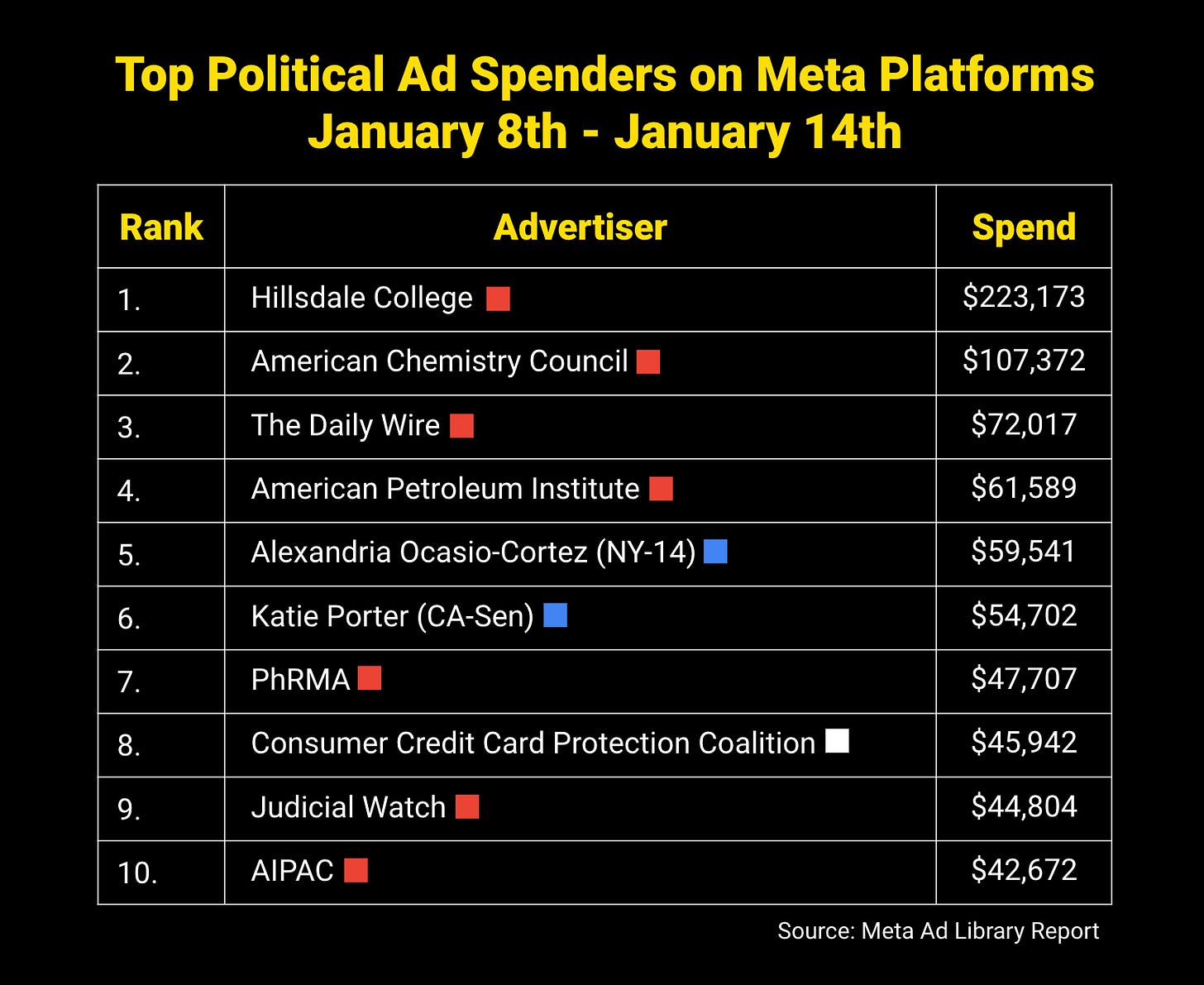2024 starting lines...
An entirely premature look at how the 2024 Republican hopefuls’ audiences stack up online
On Wednesday, NBC News reported that the Trump campaign is preparing for its imminent return to major social media platforms like Twitter and Facebook, which would provide the former President with a massive online megaphone to aid his re-election bid. In this week’s FWIW, we’ve got a snapshot of how a dozen of Trump’s potential presidential rivals stack up in terms of their own social media audiences, and whether size matters at all.
But first…
By the numbers
FWIW, here were the top-spending political advertisers on Facebook + Instagram last week:
Conservative Hillsdale College was the highest-spending political advertiser on Facebook and Instagram last week. Part marketing scam, part private Christian school, Hillsdale has long spent ungodly amounts of money on digital advertising to fundraise and recruit conservatives to take its online courses. They’ve spent $8 million on Facebook ads alone in the past three years, and over $1 million in the past 90 days.
Meanwhile, here were the top-spending political advertisers on Google and YouTube last week:
As expected, Rep. Katie Porter was the top spending political advertiser on Google ads last week, running a bunch of ads to raise money for her nascent Senate campaign. Her team is working with Middle Seat, the Democratic digital firm that also powered John Fetterman’s digital program.
Several big cities are gearing up for competitive mayoral contests this year, and that includes Philadelphia, where Democrat Allan Domb is leading spending online. His campaign is currently running YouTube ads focused on crime & public safety.
…and Snapchat has updated its public ad archive for 2023. Here are the handful of political and advocacy entities already advertising on its platform this year:
One interesting nugget we noticed here: the New York City Health Department is running ads promoting abortion services, but they’re doing so specifically targeting women in Texas, Georgia, and Florida (states that have seriously curtailed access to abortion).
From around the internet
How did the Great Gas Stove War of 2022 play out on social media? From right-wing Facebook pages to Google Search interest, millions of Americans were eager to engage with content on the topic. Read more in Climate Monitor>>
This week is the anniversary of the Supreme Court’s disastrous Citizens United decision, which opened the floodgates of big money in politics. Here’s a must-read thread on what it’s meant for our Democracy >>
Speaking of the Supreme Court, this morning the justices will weigh two major challenges to how social media platforms have regulated content for years. “It’s a moment when everything might change.”
Democratic fundraising powerhouse ActBlue has a new CEO, read all about the new leader at the Washington Post>>
Not shocking anyone who reads this newsletter, the FEC has dismissed a complaint from Republicans that Google’s Gmail app aided Democratic candidates by sending GOP fundraising emails to spam at a far higher rate than Democratic solicitations.
Our friend Michael Podhorzer has been a longtime source of progressive data wisdom, usually through private email lists and regular convenings. Last week, he joined Substack to begin to share some of his private findings with the public on a regular basis. Read his latest, “Red Wave, Blue Undertow,” and subscribe here>>
2024 social media starting lines
This week, NBC News reported that the Trump campaign is preparing for its imminent return to major social media platforms like Twitter and Facebook (and likely Instagram). Staffers are already workshopping Tweets, and Trump supposedly wrote a nice, non-threatening letter to Facebook’s parent company Meta asking for his account to be reinstated.
Despite his own investments in efforts like Truth Social to build an alternate social media universe, the former President can’t resist the tens of millions of followers awaiting him on the mainstream platforms. His following of over 34 million users on Facebook alone would dwarf those of his potential Republican primary rivals and provide Trump with a massive megaphone to reach the grassroots.
Other GOP presidential hopefuls obviously lag far behind the former President on pretty much every social media platform. Here’s a snapshot of a dozen likely Republican candidates for President and the size of their following online:










